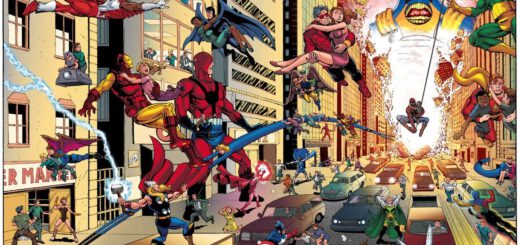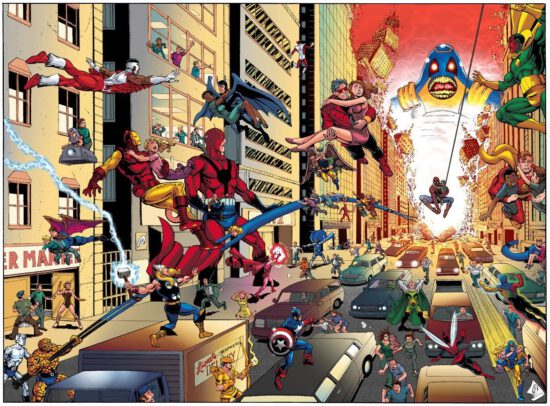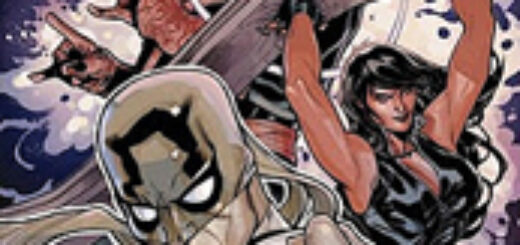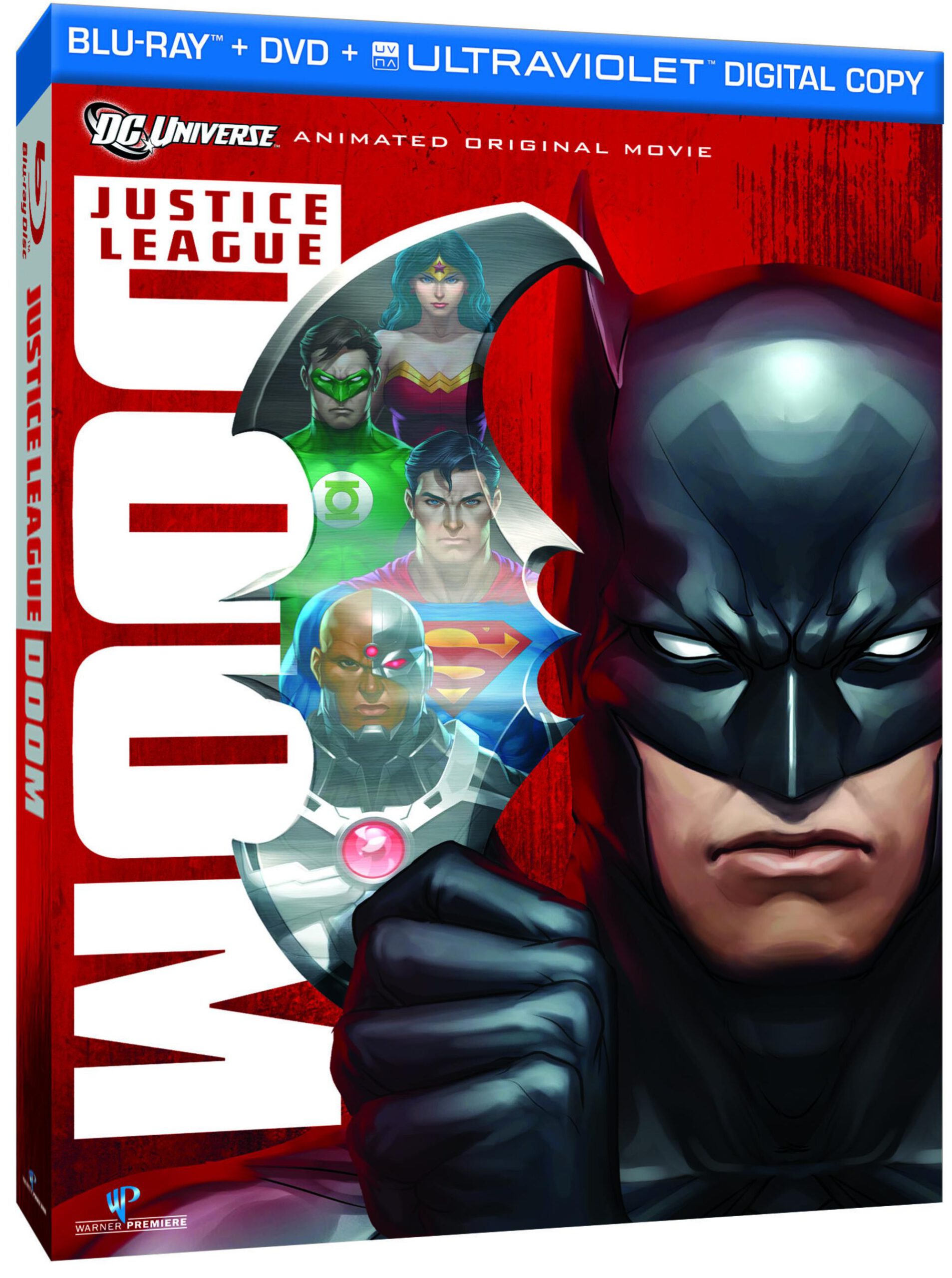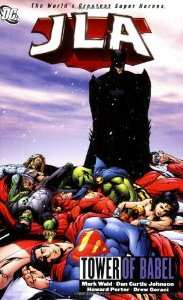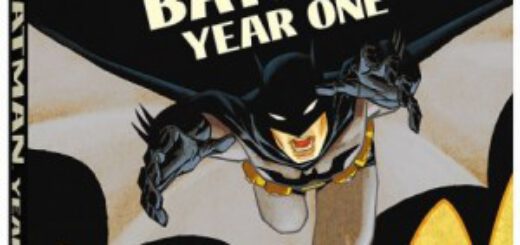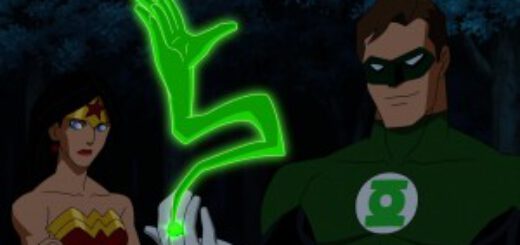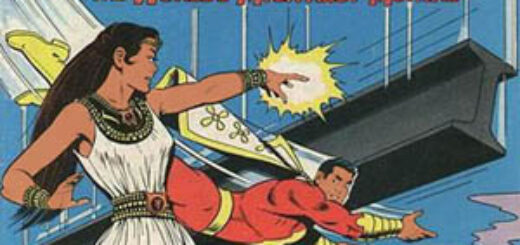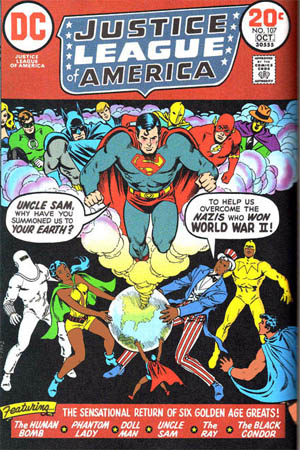Tagged: Crisis
Review: “Superman: Whatever Happened to the Man of Tomorrow?” by Alan Moore and various artists
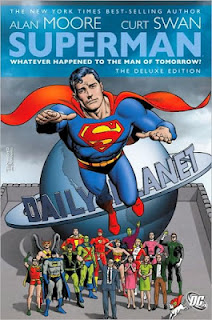 If you know this story at all, you know the quote: “This is an imaginary story…aren’t they all?” That would be true but trite if it weren’t for the fanatical identification of the superhero reader with his favorite characters — and, even more so, with the continuity of their stories. When “Whatever Happened to the Man of Tomorrow?” first appeared, in the then-last issues of Action Comics and Superman in the fall of 1986, as the decks were being cleared for what still looked then like a fresh start for DC Comics’s characters in the wake of Crisis on Infinite Earths, continuity was still something in large part built by the fans, a collective work of imagination linking the most interesting and resonant parts of a thousand stories told over five decades.
If you know this story at all, you know the quote: “This is an imaginary story…aren’t they all?” That would be true but trite if it weren’t for the fanatical identification of the superhero reader with his favorite characters — and, even more so, with the continuity of their stories. When “Whatever Happened to the Man of Tomorrow?” first appeared, in the then-last issues of Action Comics and Superman in the fall of 1986, as the decks were being cleared for what still looked then like a fresh start for DC Comics’s characters in the wake of Crisis on Infinite Earths, continuity was still something in large part built by the fans, a collective work of imagination linking the most interesting and resonant parts of a thousand stories told over five decades.
Now continuity is just another commodity: carefully spooned out, measured by drops and pints and liters, controlled almost day-by-day by the two big comics companies, as they alternate shocking reveals with the inevitable returns to the fan-preferred status quo ante. Continuity, these days, is just the name of another dead comics company — Marvel and DC tell you what the past is today, and they’ll tell you differently tomorrow, and if you don’t like it, well, where else can you get your stories of Superman and Spider-Man?
Alan Moore isn’t part of our new world, of course — even if everything else had been different, and DC hadn’t screwed him over at every possible turn over the last two decades, his sensibility couldn’t fit into the current soup of cynicism — and his superhero comics come from the ’80s and ’90s rather than now. His few actually cutting-edge works — primarily Watchmen and Miracleman/Marvelman — worked to undermine retro nostalgia, and to show what costumed heroes might be like, psychologically and physically, in something more like a real world. But most of his comics that deal with superheroes take them as icons, as the true representation of what a young Moore must have seen in them in the ’50s — from these stories to Supreme to the superheroes scurrying around the margins of Swamp Thing, trying valiantly but completely out of their depth in more complicated works of fiction.
Superman: Whatever Happened to the Man of Tomorrow? is a 2009 hardcover collecting three Alan Moore-written stories from 1985 and 1986, illustrated by different artists. The longest piece — that swan song for the Silver Age Superman — is given pride of place, first in the book with title and cover features, and it has suitably iconic art by classic Superman artists Curt Swan (inked too fussily by George Perez in the first part and more straightforwardly by equally classic Kurt Schaffenberger for the climax). Moore takes all of the pieces of Silver Age Superman’s furniture — the silly villains, the big cast with their complicated relationships, the thousand toys and wonders — and systematically breaks them all down and takes them apart, in pursuit of his big ending. It’s impressive in the context of comics of the time, though the ending, seen twenty-plus years later, is too facile and the pieces that should be tragic are just swept under the rug. But it is a Silver Age Superman story, so those are features rather than bugs: those stories can’t be any deeper than they are, or they would be something else.
The other two stories collected in this book are something else, and see Moore using Superman to tell deeper, more resonant stories: first is “The Jungle Line,” from the minor team-up book DC Comics Presents, in which Superman is infected with a deadly Kryptonian disease, and heads off to the least superhero-infested part of the USA — the Louisiana swamps — expecting to die. Instead, he runs into Swamp Thing — star of the monthly comic Moore was also doing excellent work in at the time — and finds a way not to die of his affliction. It’s strengths lie equally in Moore’s incisive captions — particularly as he examines Superman’s failing powers and growing sense of mortality — and in the art of Rick Veitch and Al Williamson, which is much more like the Swamp Thing look, lush and full and organic, than the Superman comics of the time. It’s a minor team-up story, of course — entirely about something that doesn’t happen — but it’s a small gem of its time.
The last story here, though, is something stronger than that: “For the Man Who Has Everything,” which was the Superman annual in 1985 and has Dave Gibbons’s inimitable art support: precise and utterly superheroic in every line, but modern and detailed and dramatic in ways that Swan and his cohort weren’t. It’s a story of Superman’s birthday, and of the best and worst possible present. It’s the only Superman story that has ever made me tear up, and possibly the only one that ever could: it gives Kal-El (Moore, again, is most at home with the Silver Age version of Superman that he grew up with) what he always wanted, and makes him tear himself away from it. It’s completely renormative, of course, in the style of the Silver Age, but it points directly at Watchmen, which Moore and Gibbons would start work on within a year, and it implies Moore’s growing uneasiness at always having to put all of the pieces back neatly in the same box at the end of the story.
So this book reprints three very good ’80s superhero stories by excellent creators — but readers do need to realize that these, if not actually Silver Age stories, have a Silver Age sensibility and feel to them. In particular, Moore’s DC work was very heavily captioned, which has gone entirely out of style these days. If you can’t stand a Superman who’s a big blue Boy Scout, who has a dog named Krypto and a fortress in the Arctic with a gigantic gold key, and who would never ever kill anyone under any circumstances, this is not the book for you.
Marc Alan Fishman: Help! I’m A Marvel Zombie!
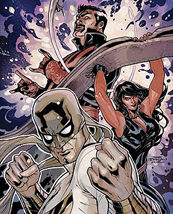 Seriously, it happened so slowly, I never saw it coming. It’s long been a fact: Marc Alan Fishman is a card carrying member of the DC Nation. But then, something changed. Flashpoint was one epic-crossover-super-event-that-changed-everything too many. With the New 52, I’d made a steadfast rule: In order to conserve money and my sanity, any book that delivered two issues in a row that left me bored or was just terrible I would remove from my pull list.
Seriously, it happened so slowly, I never saw it coming. It’s long been a fact: Marc Alan Fishman is a card carrying member of the DC Nation. But then, something changed. Flashpoint was one epic-crossover-super-event-that-changed-everything too many. With the New 52, I’d made a steadfast rule: In order to conserve money and my sanity, any book that delivered two issues in a row that left me bored or was just terrible I would remove from my pull list.
Like every red-blooded nerd worth his salt, when a book is dropped from my box, I can’t help but seek to replace it with something new. And now that I look across the board, Marvel is now on equal footing, book-for-book with my pull list for DC.
More important, every Marvel book on that list is one that when I see it on the shelf, I get truly excited. Truth be told, I get Blue Beetle, Batgirl, Justice League Dark, Green Lantern Corps, and Resurrection Man – and they are good comics, but none of them excite me anymore. I’m slowly coming to terms with it; New 52 be damned… Make Mine Marvel.
Simply put, right now Marvel is putting out better books than DC. I welcome the flame war and argument from the interwebs. Based solely on the Marvel books I’ve read in the last three-four months, DC pales in comparison in story depth, quality, scope, and clarity. A few examples, you ask?
Take the Fantastic Four. Jonathan Hickman’s run on the title has been compared to Kirby and Lee’s initial run; and said with sincerity. His “War of the Four Cities” multi-year arc was as epic as any DC “Crisis” without the multitude of mini-series. While it did spawn a second book, FF, the grandeur has been well contained. Even better, FF brings the ideology of the family and creates an excuse to explore more of the Baxter Building collective without over-saturation. It’s a riff, not a rip-off. Compare this to the four Green Lantern titles being pumped out at DC and you can see how a little consolidation can really tighten up a title’s overall quality.
How about the newly relaunched Defenders? Matt Fraction’s “vacation” title is a glorious send up to an old and mostly forgotten secondary team… dusted off, polished up, and presented wonderfully in the modern age. While only five issues in, I’ve been nothing but impressed up until now. In fact, Defenders #4 easily tops my list of best comics I’ve read for the year. The year is early, yes, but amongst dozens and dozens of issues, I’ve little doubt it won’t falter from my top ten by years end. It’s a comic not afraid to be written with a smirk… that knows when to be deadly serious, or just go for the nut shot. Something Justice League International tried to do, and fell on its face for attempting.
For those following my reviews on Michael Davis World, you’ll no doubt also note my recent jaunt into Spider-Land with the Amazing Spider-Man title. With the promise of the “Ends of the Earth” storyline being a good jumping on point for new readers, I dove into a title and character I’ve always wanted to read, but never did because of the bad mojo that came with the book. Ask anyone about Spider-Man’s most recent bullet points and I doubt you’ll see a face light up when discussing One More Day, the Other, or even Spider-Island. That being said, the series thus far has been a joyous romp. A Saturday morning cartoon concept with a hidden maturity, that has a perfect balance of comic-book-quirk with well thought out plot development.
And over in Invincible Iron Man? Well, Matt Fraction is proving what a truly potent writer he is by shaking off the grime of the horrendous Fear Itself crossover crud and taking his baby book back to form. His long-winding plot of Mandarin’s careful and calculated destruction of Tony Stark has been a slow burn that’s been a long time coming. And when everything recently came to a head, we got a moment in comics I’ve dreamed of reading since I finished The Watchmen – an arc where the hero loses because he’s been out-matched. It was bold, ballsy, and has me chomping at the bit for more.
All this, and I’ve not even mentioned Daredevil or Ultimate Spider-Man. I’d love to, but well… I’ve not read them yet. But they are high on the list for me to catch up on, the second the next DC book takes a dive in my box. Resurrection Man? I’m looking at you.
Now, of course, Marvel isn’t perfect. Just a few weeks back on my podcast, a lifelong X-Men fan told me he’d literally given on comics all together because of the terrible decline of his favorite mutants. And let’s give credit where credit is due: Fraction and Hickman’s bold pacing is very much in-step with Geoff Johns and Grant Morrison’s work on Green Lantern and Batman over the last 60 or so issues. Anyone who read “Batman R.I.P.” can see what “The War of the Four Cities” or most of the run on Invincible Iron Man is being inspired by (not directly mind you… but certainly in conceptual scope). And DC is not without its own amazing titles. Action Comics, Batman, Animal Man, Swamp Thing, and Green Lantern always float to the top of my reading pile when I pick them up.
This of course leads me to ask the bigger questions. Was the New 52 not powerful enough overall to keep me from being lured away? Is Marvel just in a great rhythm right now? Will X-Men vs. Avengers cause some major crisis to interrupt all the goodness coming out in their top titles? Or with the second wave of new books (Dial H and JSA are both looking mighty fine to me…) hitting shelves soon, will DC reclaim me?
Don’t worry, I’ll let you know.
SUNDAY: John Ostrander Feeds The Chickens
“Justice League: Doom” on DVD February 28
 Earth’s greatest super heroes face foes on all fronts – using a plan initiated from within – in the all-new [[[Justice League: Doom]]], the next entry in the popular, ongoing series of DC Universe Animated Original Movies. Produced by Warner Premiere, DC Entertainment and Warner Bros. Animation, the all-new, PG-13 rated film arrives February 28, 2012 from Warner Home Video.
Earth’s greatest super heroes face foes on all fronts – using a plan initiated from within – in the all-new [[[Justice League: Doom]]], the next entry in the popular, ongoing series of DC Universe Animated Original Movies. Produced by Warner Premiere, DC Entertainment and Warner Bros. Animation, the all-new, PG-13 rated film arrives February 28, 2012 from Warner Home Video.
Justice League: Doom finds Superman, Wonder Woman, Flash, Green Lantern, Martian Manhunter, Cyborg and Batman on their heels when a team of super villains discover and implement the Dark Knight’s “contingency plans” for stopping any rogue Justice League member. The story is inspired by Mark Waid’s much-heralded “JLA: Tower of Babel.” The trailer for the movie is here.
Primetime television stars Nathan Fillion (Castle) and Tim Daly (Private Practice), the reigning voices of Green Lantern and Superman, respectively, join a group of eight actors reprising their famed Justice League cartoon roles. Fillion made his debut as Green Lantern/Hal Jordan in the recent Green Lantern: Emerald Knights, and took his initial DC Universe movie bow as the voice of Steve Trevor in the 2008 hit Wonder Woman. Daly originated his role as Superman’s voice in the landmark cartoon, Superman: The Animated Series. He has reprised the role in two DC Universe films: the 2009 extravaganza Superman/Batman: Public Enemies and the 2010 thriller Superman/Batman: Apocalypse.
“Justice League: Doom” Trailer Unveiled
Warner Home Video has released the official trailer for Justice League: Doom, an all-new entry in the popular series of DC Universe Animated Original Movies due in early 2012 on Blu-ray, DVD, OnDemand and for Download.
Justice League: Doom finds Superman, Wonder Woman, Flash, Green Lantern, Martian Manhunter, Cyborg and Batman on their heels when a team of super villains discover and implement the Dark Knight’s “contingency plans” for stopping any rogue Justice League member. The story is inspired by Mark Waid and Howard Porter’s much-heralded JLA: Tower of Babel.
Primetime television stars Nathan Fillion (Castle) and Tim Daly (Private Practice), the reigning voices of Green Lantern and Superman, respectively, join a group of eight actors reprising their famed cartoon roles, including Kevin Conroy (Batman: The Animated Series) as Batman, Michael Rosenbaum (Smallville, Breaking In) as Flash, Susan Eisenberg (Superman/Batman: Apocalypse) as Wonder Woman and Carl Lumbly (Alias) as J’onn J’onzz/Martian Manhunter. Also returning to their Justice League animated series roles are the villainous voices of Phil Morris (Smallville, Seinfeld) as Vandal Savage, Olivia d’Abo (The Wonder Years) as Star Sapphire, and Alexis Denisof (Angel) as Mirror Master. David Kaufman (Danny Phantom) also reprises his Justice League role of Jimmy Olsen.
The film is executive produced by Bruce Timm (Batman: Year One), and directed by Lauren Montgomery (Batman: Year One), who is also credited as producer alongside Alan Burnett (Batman: The Animated Series). Justice League: Doom is the final script from the late Dwayne McDuffie (All-Star Superman, Justice League: Crisis on Two Earths). Casting and dialogue direction is once again in the capable hands of Andrea Romano (Batman: Year One, SpongeBob SquarePants).
[youtube]http://www.youtube.com/watch?v=uBrvW9FbfDw[/youtube]
Batman: Year One
 Crisis on Infinite Earths reset the playing field for DC Comics (at least for a little while before it was reset again and again and again), allowing management to refresh their top trio of heroes. Given the groundbreaking work Frank Miller did on The Dark Knight, he was invited to help editor Denny O’Neill essentially reboot Batman from the beginning. In November 1986, fans were delighted with the effort in the form of Batman #404, the first installment in “Batman: Year One”. This not only reset the Darknight Detective and his mythos, but gave publishers the mini-series within a series, which became a template along with the chance to revisit the past with the Year One moniker.
Crisis on Infinite Earths reset the playing field for DC Comics (at least for a little while before it was reset again and again and again), allowing management to refresh their top trio of heroes. Given the groundbreaking work Frank Miller did on The Dark Knight, he was invited to help editor Denny O’Neill essentially reboot Batman from the beginning. In November 1986, fans were delighted with the effort in the form of Batman #404, the first installment in “Batman: Year One”. This not only reset the Darknight Detective and his mythos, but gave publishers the mini-series within a series, which became a template along with the chance to revisit the past with the Year One moniker.
Partnered with artist David Mazzuccehlli, who worked so well with Miller on a run of Daredevil, they helped give us fresh takes on Bruce Wayne, Alfred, and most notably Jim Gordon. Controversially, it also gave us Selina Kyle as a prostitute, something creator shave been trying to paper over ever since. Still, the story of corruption, adultery, redemption, and a man learning to become a hero was gripping stuff.
There’s little wonder then why Warner Premiere decided to adapt this seminal tale as part of their largely successful line of direct-to-video animated features. Much like the source material, this film runs a spare 64 minutes. Everything from the four issues is present and we really see that this is more about Gordon than Batman, giving him some deep roots for the first time. (more…)
Nathan Fillion & Tim Daly join heroic cast of Justice League: Doom
 Primetime television stars Nathan Fillion and Tim Daly, the reigning voices of Green Lantern and Superman, respectively, join an exciting group of actors reprising their famed cartoon roles in Justice League: Doom, an all-new entry in the popular series of DC Universe Animated Original Movies due in early 2012 from Warner Home Video.
Primetime television stars Nathan Fillion and Tim Daly, the reigning voices of Green Lantern and Superman, respectively, join an exciting group of actors reprising their famed cartoon roles in Justice League: Doom, an all-new entry in the popular series of DC Universe Animated Original Movies due in early 2012 from Warner Home Video.
Justice League: Doom finds Superman, Wonder Woman, Flash, Green Lantern, Martian Manhunter, Cyborg and Batman on their heels when a team of super villains discover and implement the Dark Knight’s “contingency plans” for stopping any rogue Justice League member. The story is inspired by Mark Waid’s much-heralded JLA: Tower of Babel.
Fillion, the star of ABC’s hit TV drama Castle, made his debut as Green Lantern/Hal Jordan in the recent Green Lantern: Emerald Knights. Fillion made his initial DCU bow as the voice of Steve Trevor in the 2008 hit Wonder Woman.
Currently headlining the cast of ABC’s popular Private Practice, Daly originated the title character’s voice in the landmark cartoon, Superman: The Animated Series. He has reprised the role in two DCU films: the 2009 extravaganza Superman/Batman: Public Enemies and the 2010 thriller Superman/Batman: Apocalypse.
 In addition to current primetime stars Fillion and Daly, the cast is a grand reunion of the original group of actors who provided the voices of the Justice League for the cartoon of the same name and its follow-up, Justice League Unlimited. Reprising their roles are Kevin Conroy (Batman: The Animated Series) as Batman, Michael Rosenbaum (Smallville, Breaking In) as Flash, Susan Eisenberg (Superman/Batman: Apocalypse) as Wonder Woman and Carl Lumbly (Alias) as J’onn J’onzz/Martian Manhunter. Bumper Robinson (A Different World, Transformers: Animated) joins the cast as Cyborg.
In addition to current primetime stars Fillion and Daly, the cast is a grand reunion of the original group of actors who provided the voices of the Justice League for the cartoon of the same name and its follow-up, Justice League Unlimited. Reprising their roles are Kevin Conroy (Batman: The Animated Series) as Batman, Michael Rosenbaum (Smallville, Breaking In) as Flash, Susan Eisenberg (Superman/Batman: Apocalypse) as Wonder Woman and Carl Lumbly (Alias) as J’onn J’onzz/Martian Manhunter. Bumper Robinson (A Different World, Transformers: Animated) joins the cast as Cyborg.
The Justice League faces two sets of villainous teams in the film – The Royal Flush Gang and a sextet of notable evildoers. The latter group includes three voice acting alumni of the Justice League animated series: Phil Morris (Smallville, Seinfeld) as Vandal Savage, Olivia d’Abo (The Wonder Years) as Star Sapphire, and Alexis Denisof (Angel) as Mirror Master. Also opposing our heroes are Carlos Alazraqui (Reno 911) as Bane, Paul Blackthorne (The Dresden Files) as Metallo, and Claudia Black (Farscape, Stargate SG-1) as Cheetah.
David Kaufman (Danny Phantom) also reprises his Justice League role of Jimmy Olsen.
The film is executive produced by Bruce Timm (Batman: Year One), and directed by Lauren Montgomery (Batman: Year One), who is also credited as producer alongside Alan Burnett (Batman: The Animated Series). Justice League: Doom is the final script from the late Dwayne McDuffie (All-Star Superman, Justice League: Crisis on Two Earths). Casting and dialogue direction is once again in the capable hands of Andrea Romano (Batman: Year One, SpongeBob SquarePants).
Warner Home Video will premiere the Justice League: Doom trailer during its presentation at New York Comic Con on Friday, October 14 from 3:00-4:00 p.m. in the IGN Theater. Also premiering during that session will be the Catwoman animated short that is attached to Batman: Year One, the next DC Universe Animated Movie (streeting October 18).
If I rebooted Wonder Woman
This is the Wonder Woman I would choose:
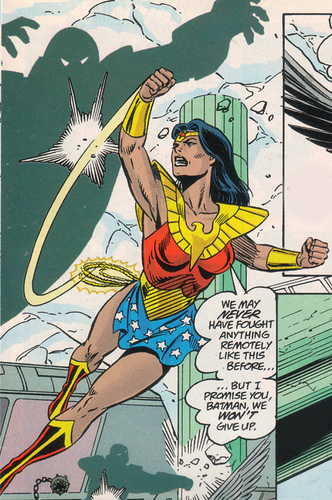
She’s from Legends of the DCU: Crisis on Infinite Earths #1. The designer solved a problem that’s defeated every other attempt to fix her costume: he turned the eagle symbol into something that both holds up her costume and suggests armor.
I dunno who suggested that costume, but I suspect the writer, Marv Wolfman, suggested she look Middle-Eastern. It makes sense. In classical literature, the island of the Amazons has been located in Libya and Asia Minor.
While I like the skirt, I would be tempted to give her pants. And there’s something to be said for a longer skirt like the one she first wore:
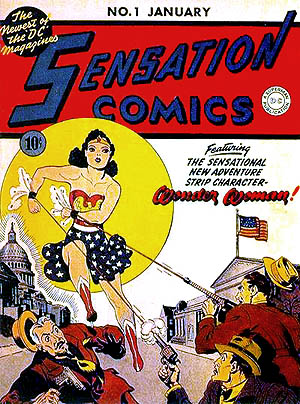
There was an excellent analysis of Wonder Woman, “Wonder Woman, Delineated” at Fractal Hall, a site that’s no longer on the web. The writer proposed:
So, what makes her work?
A) Truth. Truth truth truth truth truth.
B) The hunt.
C) Magical gadgets
D) Super-strong, super-fast.Factor A is more subtext than explicit, but I think it’s fair to say that any Wonder Woman story has to have a theme of honesty or a counter-theme of dishonesty to it.
Part of what I admired about the Fractal Hall analyses of superheroes was the way they began with the essential differences in genres: Superman is a science fiction character, Wonder Woman is a fantasy character, and the Batman is what they called a crime character, but I would call a mystery character. The worlds of Superman, Batman, and Wonder Woman are so different that they should only meet when the Justice League gathers.
Will Shetterly is the creator of [[[Captain Confederacy]]], the author of [[[Dogland]]], and the co-creator of [[[Liavek]]] with his wife, Emma Bull.
If I rebooted Batman and Robin
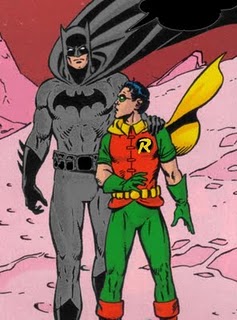 This is a light modification of a panel in Legends of the DCU: Crisis on Infinite Earths #1. I could go either way on making Batman’s costume black and gray or blue and gray, but for a creature of the night, the yellow belt made no sense, and the panties were just too 1940s.
This is a light modification of a panel in Legends of the DCU: Crisis on Infinite Earths #1. I could go either way on making Batman’s costume black and gray or blue and gray, but for a creature of the night, the yellow belt made no sense, and the panties were just too 1940s.
My Batman’s personality is inspired by the 1960s “New Look” Batman: he’s a detective who has mostly made peace with the fact that he can’t bring his parents back from the dead. He doesn’t like putting Robin in danger, so Robin is a supporting character, someone who goes undercover in places where Batman can’t and who usually has adventures on his own or with the Titans. Their styles are so different that they shouldn’t team up often: Batman’s inspiration is the creature of the night; Robin’s inspiration is the people’s hero, Robin Hood. The only reason Batman trains Robin is because he realizes that the kid will fight crime no matter what Batman does, so he might as well do what he can as mentor and friend.
The Bruce Wayne playboy is not a “cover”. Batman thinks of himself as a soldier or a spy who works hard and parties hard. He knows he needs R&R to keep doing his duty, and he wants fun that won’t result in anyone becoming too fond of him. He’s an adrenaline junkie, and sometimes, late at night, he wonders if he has a bit of a death wish. If so, so long as it helps him do his job, he’s fine with that.
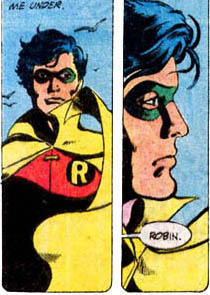 The capes can become rigid and serve as gliders. Otherwise, why are acrobats wearing capes? Other than they look cool? Which, I grant, in a comic book is never automatically the wrong answer. The trick to making the original Robin cape work is to use the collar. George Perez understood that.
The capes can become rigid and serve as gliders. Otherwise, why are acrobats wearing capes? Other than they look cool? Which, I grant, in a comic book is never automatically the wrong answer. The trick to making the original Robin cape work is to use the collar. George Perez understood that.
But I would be tempted to make Robin’s cape green.
As for the Batmobile, its time has passed. Batman and Robin should patrol from a Batplane that can hover in place.
Will Shetterly is the creator of [[[Captain Confederacy]]], the author of [[[Dogland]]], and the co-creator of [[[Liavek]]] with his wife, Emma Bull.
Dear DC, Please Keep Captain Marvel Black!
You’re rebooting your universe, and I approve. Comic books should be rebooted every decade to keep them vital. Having a younger Superman who was never married makes sense. I only have one plea: please, keep Captain Marvel black.
I’m old enough to remember the early ‘70s when DC had the best female superheroes, Wonder Woman, Supergirl, and Batgirl, and Marvel had the best black superheroes, the Black Panther, the Falcon, and Luke Cage.
But everything changed in 1973 when DC expanded its universe with characters that had been published by other companies. Justice League #107 introduced the Quality Comics superheroes. Here’s that groundbreaking cover:
With one stroke, DC accomplished two things. One was obvious: it leapt ahead of Marvel on diversity, creating four African-American heroes, a Mexican-American Black Condor and a Japanese-American Human Bomb (which seems simplistic now, but was a daring commentary on nuclear weapons then).

